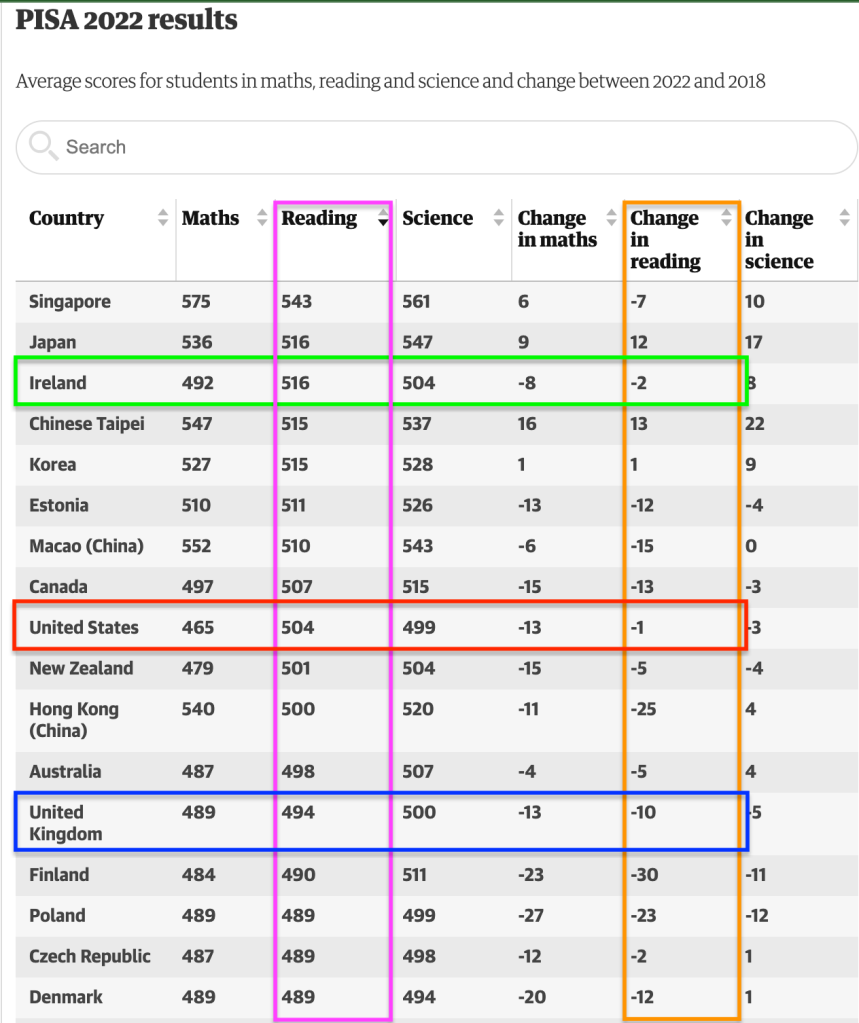Radical Eyes for Equity: UK PISA 2022 Results Offer Cautionary Tale for Us Reading Reform
From the SAT and National Assessment of Educational Progress (NAEP) in the US to Programme for International Student Assessment (PISA), student test scores tend to prompt over-reactions in the media and among political leaders.
Even Finland, recently the Golden Country for educational outcomes, now finds itself with the release of PISA 2022 facing headlines like this: PISA 2022: Performance in Finland collapses, but remains above average.
However, the best lesson from PISA 2022 for the US is England (UK), especially in the context of the “science of reading” (SOR) movement driving state-level reading legislation across the country:

First, for context, England implemented phonics-centered reading policy in 2006 that rejected balanced literacy and parallels in most ways the elements of SOR-based reading legislation in the US. Research on those policies shows that students have received systematic phonics for almost two decades now, but that outcomes have not produced the promises of that reform.
UK PISA scores in reading, none the less, rank below the US along with Australia, New Zealand, Canada, and Ireland; as well, the UK suffered a large score decrease in the wake of Covid:

While how reading is taught, what reading theory is embraced, and what reading programs are being implemented vary significantly across these countries, they all have one thing in common—perpetual reading crisis.
In fact, since A Nation at Risk, the US has endured several cycles of education crisis and reform that often hyper-focuses on reading (notably the impact of the National Reading Panel in No Child Left Behind).
Yet, none of these reforms have fulfilled promised outcomes, just as we are witnessing in the UK.
PISA 2022 and England’s reading results, then, offer some lessons we have refused to acknowledge about reading and education reform:
- Education reform that exclusively implements in-school-only reform is guaranteed to fail. The value-added methods (VAM) era under Obama revealed that teacher impact on measurable student achievement is only 1-14%, and NAEP data show that the most successful schools in the country are Department of Defense (DoDEA) schools where the inequity of children’s lives are mitigated by access to healthcare, stable housing, food security, etc.
- Media coverage and political rhetoric proclaiming “crisis” have repeatedly misidentified the barriers to reading proficiency and teaching reading, and thus, have resulted in policy that doesn’t address those roots causes. As the UK shows, making promises that are not fulfilled only further fuels cycles of crisis and reform. Currently in the US, SOR advocates are promising 90% of students will be at grade level proficiency; however, a recent working paper on reading reform in California show only about 1/3 of students as proficient after SOR implementation, the same percentage that media has used to claim a reading crisis and a far cry from 90%.
- PISA is a measure of 15-years-old students (see also NAEP LTT data), which offers a way to evaluate misleading short-term score gains that are more mirage than miracle. In the US, states such as Florida and Mississippi demonstrate that while grade 4 scores in reading can be inflated, that learning isn’t real, and by middle and high school, the improvements have vanished. Thus, there are no miracles and no silver bullets in education reform.
Whether NAEP or PISA, standardized test scores are less about learning and teaching but more about the incredible inequity in the lives and schooling of children.
That inequity is no crisis; that inequity is a historical fact, especially in the US where we do not have the political will to confront both the out-of-school and in-school influences on teaching and learning.
If we are concerned about the disproportional vulnerable populations of students who routinely test well below the many different criteria for reading proficiency—and we should—reading and education reform must start with addressing inequity in the lives and education of all children.
Reading theories and reading programs are neither the problems nor the solutions to increasing student reading proficiency.
The real reading crisis in the US and internationally is the refusal by those with power to read what test scores actually show us—and the failure to act in ways that can and will make attainable gains in the best interest of children, teachers, and each nation.
This blog post has been shared by permission from the author.
Readers wishing to comment on the content are encouraged to do so via the link to the original post.
Find the original post here:
The views expressed by the blogger are not necessarily those of NEPC.
